Tea and Proust at the Ritz Paris
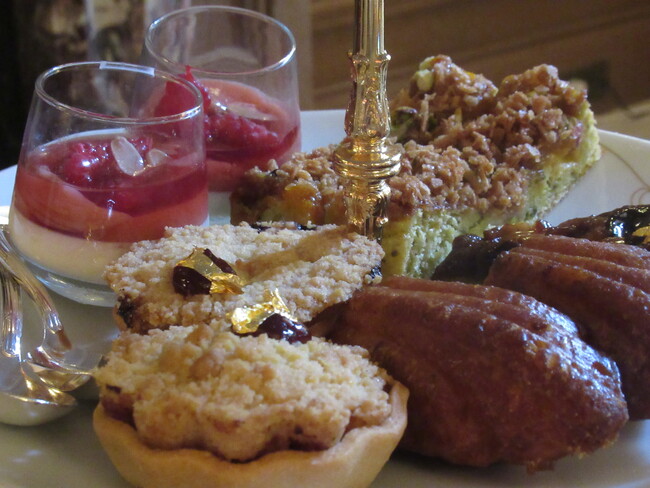

- SUBSCRIBE
- ALREADY SUBSCRIBED?
BECOME A BONJOUR PARIS MEMBER
Gain full access to our collection of over 5,000 articles and bring the City of Light into your life. Just 60 USD per year.
Find out why you should become a member here.
Sign in
Fill in your credentials below.
I donned my poshest frock for tea at the Ritz and assumed that was why no one challenged us as imposters when we arrived. Or, more likely, the staff have such impeccable manners that they wouldn’t dream of querying the booking form we waved at everyone as we approached the marble-pillared entrance and stepped inside. I wanted to squeak with excitement as I crossed the Ritz, Paris emblem on the floor and had to work hard on my “this-is-just-what-I-normally-do” expression.
It took six members of staff to see us to our seats in the Salon Proust where afternoon tea is served every day. Yes, I counted. As we passed the doorman, a uniformed figure greeted us and passed us directly to a colleague across the hallway who opened a door into a corridor – think blue carpets, chintzy armchairs in secluded alcoves, golden lighting – where our next host awaited us. He accompanied us the ten or so steps to the Salon’s entrance, where we were passed on to a receptionist who called a waiter to take us the two or three meters to our table. Eager for us to be immediately comfortable, he lost no time in finding a footstool for me to put my handbag on. I rose to the occasion and refrained from telling him I usually think nothing of parking it on the floor.
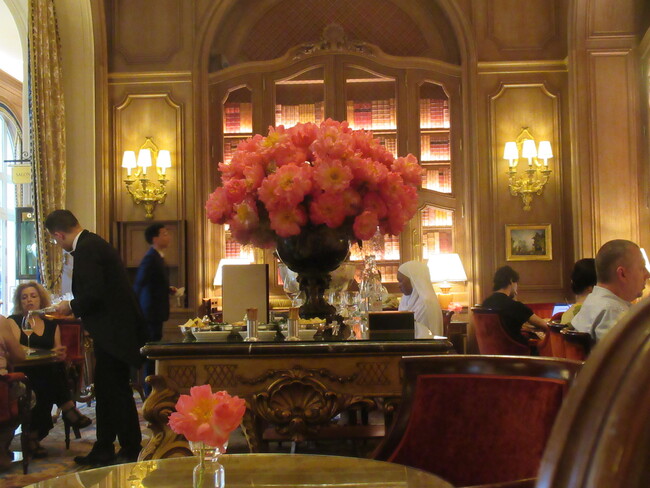
Salon Proust at the Ritz Paris. Photo: Marian Jones
It was clearly going to be quite some occasion. We sat back in our low armchairs to contemplate the scene. A portrait of Marcel Proust himself hung just above us, surveying the strangers now occupying the hotel where he so often took refuge from society. His expression conveyed that he didn’t quite know what to make of us. The gold-framed mirrors and carriage clocks glowed discreetly in the low lighting, the black-clad waiters padded solicitously to and fro, the restrained atmosphere was relieved here and there by vases of frothy pink flowers. Across the room, a Proust work – L’Arche et la Colombe – sat facing us in a bookcase otherwise filled with mock leather-bound tomes. To me, the backdrop was a metaphor for the way his work is often seen today, as something we celebrate, but find too long and difficult to read at any great length.
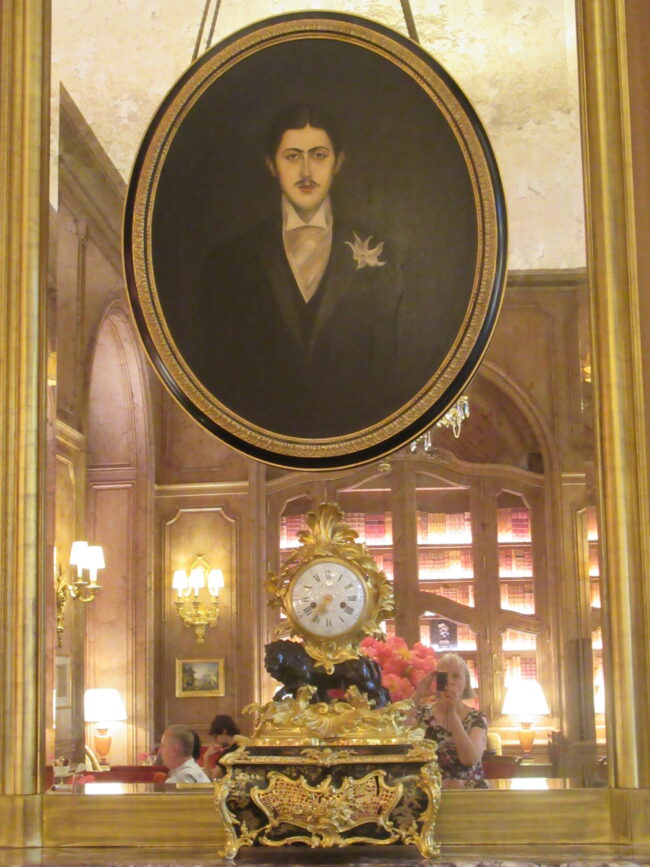
Proust portrait at the Ritz Paris. Photo: Marian Jones
The menu was also a cerebral challenge and the drink options were especially baffling. Tea, coffee, so far, so good, but Champagne Barons de Rothschild Réserve Ritz, French bloom non-alcoholic sparkling wine, non-alcoholic cocktails, how to pick through that? The waiter, spotting our novice status, patiently explained that we should choose a hot drink, which would come with an appetizer, then the cakes would follow, along with a cold drink of our choice. Tea before the meal? Odd, I thought, but feeling it not my place to overturn more than a century of tradition – the Ritz Paris opened in 1898 – I just nodded, wisely I hope.
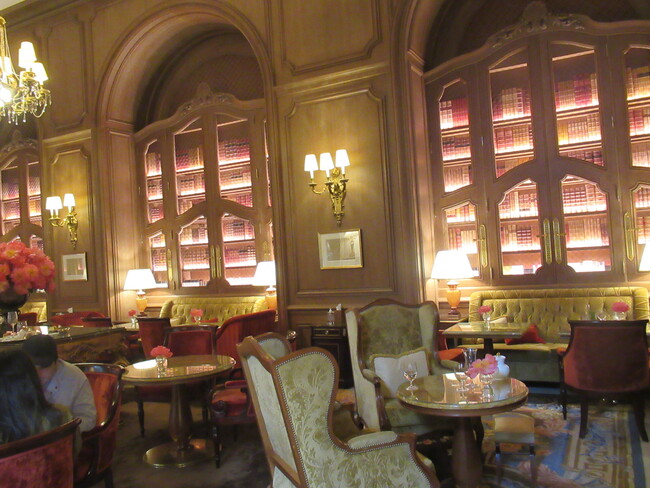
Salon Proust at the Ritz Paris. Photo: Marian Jones
Our waiter realised a little more explanation would not go amiss. Did Madame realize this would be very much à la française, that is all sweet, no savories. I erased my mental images of cucumber sandwiches and tiny sausage rolls and nodded again, hoping to convey, modestly, that of course I knew that. I had read beforehand that there would be eleven (eleven!) different cakes, a notion I thought I’d completely mastered, so it was a big surprise to discover that it actually meant eleven each. Twenty-two delicately crafted little morsels were on their way to us and I could only hope that there would be a doggie-bag option.
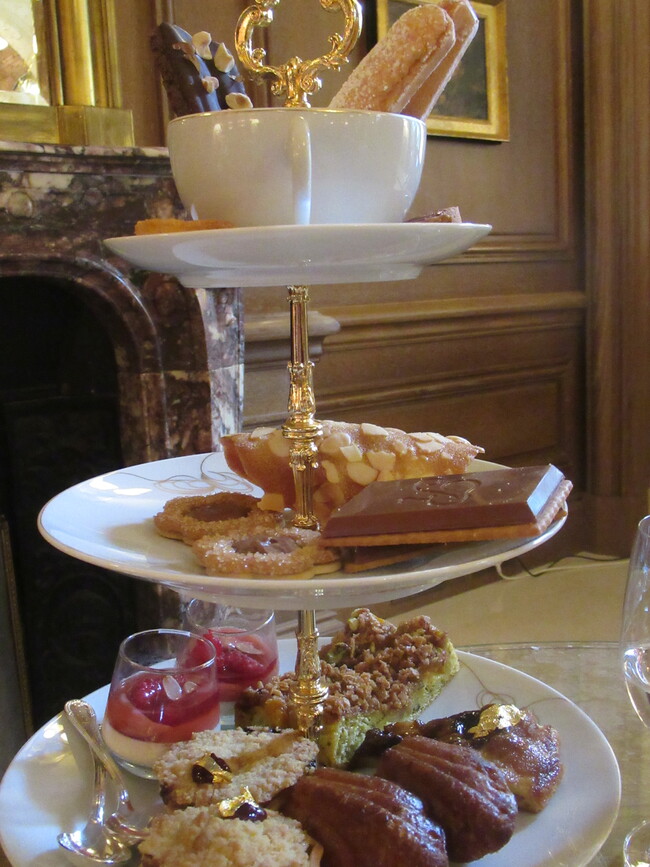
Tea at the Ritz Paris. Photo: Marian Jones
The visual highlights were many. A three-tiered china stand, white with gold trim, displayed an exquisite array of mini gâteaux in a subtle rainbow of colors, a hint of pistachio green here, delicate pink and white layers there, a splash of gold to decorate one tartlet – was it edible? – and a smooth layer of chocolate covering another. Prettiest of all was my non-alcoholic cocktail, a jubilant pink glassful of sparkling rose lemonade, raspberry and lychee juice, decorated with rose petals and a tiny lychee. Just exquisite. My husband, whose knowledge of tropical fruit rather lacks depth, broke the mood by enquiring, “Is that an onion?” I hoped the waiter hadn’t heard.
I began matching the little treats to the names on the menu. The barquette framboise must be the jam-and-biscuit sandwich, albeit in a sophisticated boat-shaped design, the brioche abricot-pistache was recognizable from its pale green layer, and I spotted the petit écolier because it did indeed look a little like the supermarket version, those little chocolate-covered rectangles enjoyed in TV adverts by French schoolchildren snacking between le déjeuner and le dîner. The financier would be the one shaped like a gold bar and the tuile aux amandes the one covered with flaked almonds. The lunette crème noisette was surely the one whose two little discs looked, if you squinted, like a pair of spectacles.
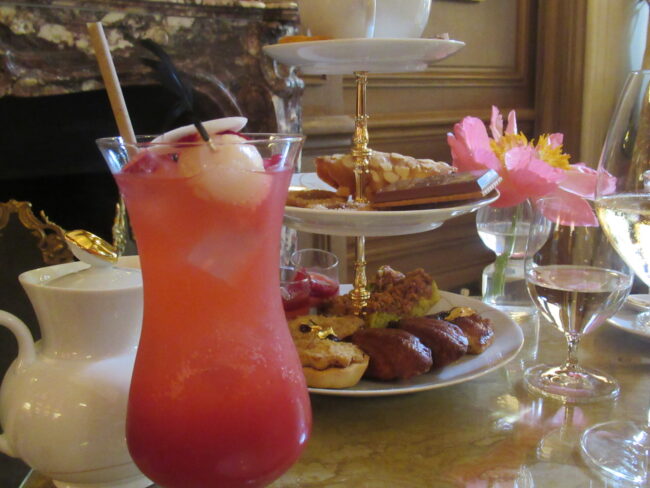
Afternoon tea at the Ritz Paris. Photo: Marian Jones
On the rest, I admitted defeat. Could our waiter spare the time to talk us through them? He suppressed a smile and threw himself into it. The biscuit de Reims – a sort of sponge finger – was designed for dunking, he explained, perhaps in champagne. Ah, I realized, that explains the name. The verrine was of course – how did the linguist in me not work this out? – the one in a little glass, pretty layers of vanilla and raspberry cream and a soupçon of peach. The far breton, a buttery, custardy treat from Brittany and the crumble, perhaps a nod to British cuisine, almost completed the set. And finally, there was the totally expected, the symbolic, the utterly Proustian madeleine.
It’s an understatement to say that Marcel Proust had a tendency to verbosity, yet the description of the madeleine with which he opened the scene at the beginning of his childhood memoirs is remarkably prosaic: “one of those … squat, plump little cakes which look as if they had been moulded in the flute valve of a scallop shell.” It was this little cake which prompted the 7-volume work A la Recherche du Temps Perdu (In Search of Lost Time), because tasting one as an adult reminded him of a scene in his childhood and unleashed a flood of memories.
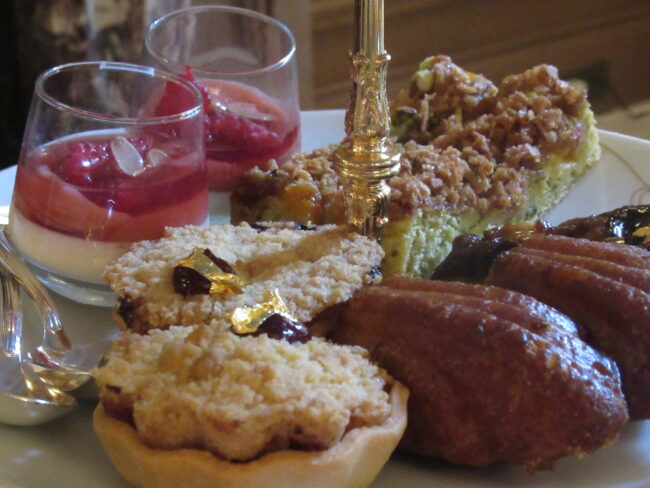
Afternoon tea at the Ritz Paris. Photo: Marian Jones
He described towards the beginning of volume 1, Swann’s Way, how biting into a madeleine took him back to a moment years earlier when his elderly aunt had given him a morsel of cake dipped in lime-blossom tisane and how from that memory his entire childhood came back to him in minute detail. First, he pictured his aunt’s room, then the old grey house she lived in and its surroundings, namely “the square where I used to be sent before lunch, the streets along which I used to run errands, the country roads we took when it was fine ….. in that moment all the flowers in our garden and in Monsieur Swann’s park, and the water lilies on the Vivonne and the good folk of the village and their little dwellings and the parish church and the whole of Combray and its surroundings, taking shape and solidity, sprang into being.”

Salon Proust at the Ritz Paris. Photo: Marian Jones
The sight of the madeleine nestling among the other cakes made me recall my attempt to read the opening volume of Proust’s memoir. The first 50 pages or so described an evening when the infant Marcel had been put to bed, but his mother, preoccupied with guests, had not come to kiss him goodnight. I found it slow going. I began to wonder how many of the million plus words of A la Recherche du Temps Perdu lay between me and the incident I’d read so much about, the moment when the author recalled the momentous mouthful of madeleine and its effect on him. I was relieved to come across it just as the bedtime incident petered out and before chapter one came, finally, to an end. Reader, I decided this was the moment to stop.
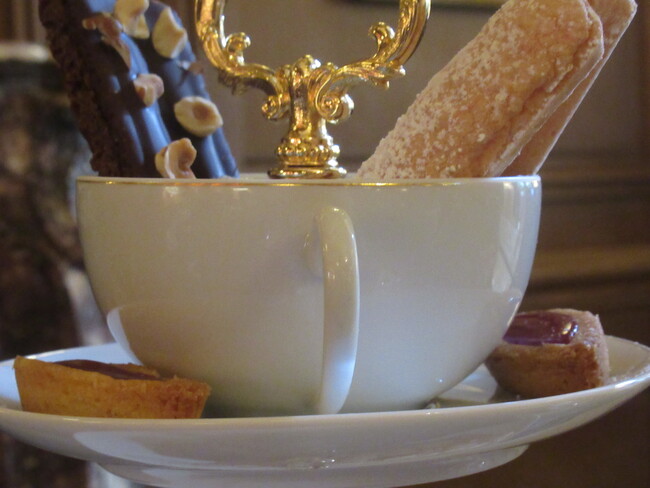
Afternoon tea at the Ritz Paris. Photo: Marian Jones
I am not proud of this. I know that for many, such as the American author Edmund White, this work is “the most respected novel of the 20th century.” But when I told my son, an English teacher and lover of literature, that I had abandoned it one chapter into the million plus words of the whole oeuvre, he replied, “Oh, everyone gives up on Proust at some point.”
As I watched the waiter putting the cakes we hadn’t managed to finish into a stiff, royal blue carrier bag with gold lettering, I reflected on what will be, from now on, my very own Proustian moment. Whenever I eat a madeleine I will be instantly transported to the Ritz Paris, to the elegant surroundings where I savored a selection of the nicest little pâtisseries I’ve ever eaten, watched over by Marcel Proust himself. I hope he’d be happy about that. I hope he wouldn’t think I’m a lightweight.
DETAILS
Ritz Paris
Afternoon tea is held in the Salon Proust every day from 2 pm- 5:30 pm.
The price is €95 per person.
Lead photo credit : Tea at the Ritz Paris. Photo: Marian Jones
More in afternoon tea, Afternoon Tea in Paris, Marcel Proust, Ritz Paris



REPLY
REPLY